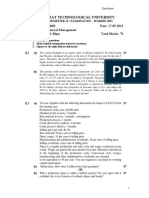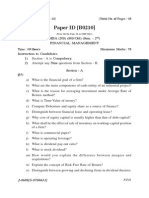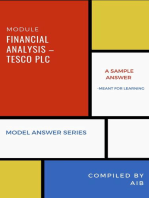Institute of Management Technology: Centre For Distance Learning
Institute of Management Technology: Centre For Distance Learning
Uploaded by
abhimani5472Copyright:
Available Formats
Institute of Management Technology: Centre For Distance Learning
Institute of Management Technology: Centre For Distance Learning
Uploaded by
abhimani5472Original Title
Copyright
Available Formats
Share this document
Did you find this document useful?
Is this content inappropriate?
Copyright:
Available Formats
Institute of Management Technology: Centre For Distance Learning
Institute of Management Technology: Centre For Distance Learning
Uploaded by
abhimani5472Copyright:
Available Formats
INSTITUTE OF MANAGEMENT TECHNOLOGY
CENTRE FOR DISTANCE LEARNING
GHAZIABAD
End-Term Examinations – June 2011
Subject Code : IMT-07 Time Allowed : 3 Hours
Subject Name: Working Capital Management Max. Marks : 70
Notes: (a) Answer any FOUR questions from SECTION-A and CASE STUDY as given in SECTION-B.
Each Question (SECTION-A) carries 14 MARKS and (SECTION-B) Case Study carries 14 MARKS.
(b) For students enrolled before January 2008, the Question Paper would be treated for 50 marks instead of 70 marks.
(c) No doubts/clarifications shall be entertained. In case of doubts/clarifications, make reasonable assumptions and proceed.
SECTION-A MARKS : 56
1. Define and describe the difference between the operating cycle and cash conversion cycle for a typical
manufacturing company.
2. What is the general objective of accounts receivable management? In what ways is it similar and different
from cash balance management and inventory management?
3. What is the significance of Economic Order Quantity to the financial manager?
4. Define the following terms:
a. Permanent asset investments
b. Temporary asset investments
c. Permanent sources of financing
d. Temporary sources of financing
5. What key variable should be considered when evaluating possible changes in the firm’s credit policy? Briefly
explain the possible effects of a more restrictive credit policy on:
a. Sales volume
b. Average collection period
c. Investment in receivable
d. Bad debt costs
6. Rohit Sportswear Company sells 750 ski parkas each year, which it purchases for Rs. 25 each. It costs Rohit
Rs. 6 to place an order for parkas and 10% to carry them in inventory.
a. What is Rohit’s economic order quantity for parkas and how many orders should it place each year?
b. What is the value of Rohit’s average parkas inventory?
c. What is the total costs of this inventory policy?
7. The Zocco Corporation has an inventory conversion period of 75 days, a receivables collection period of 38
days, and a payables deferral period of 30 days.
a. What is the length of the firm’s cash conversion cycle?
b. If Zocco’s annual sales are Rs. 3,421,875 and all sales are on credit, what is the firm’s investment in
accounts receivable?
c. How many times per year does Zocco turn over its inventory?
ETE-June 2011 Page 1 of 2 IMT-07
SECTION-B (Case Study) MARKS : 14
To increase sales from their present annual $24 million, Kim Chi Company, a wholesalers, may try more liberal
credit standards. Currently, the firm has an average collection period of 30 days. It believes that, with increasingly
liberal credit standards, the following will result:
Credit Policy
A B C D
Increase in sales from previous level (in millions) $2.8 $1.8 $1.2 $0.6
Average collection period for incremental sales (days) 45 60 90 144
The prices of its products average $20 per unit, and variable costs average $18 per unit. No bad debt losses are
expected. If the company has a pre tax opportunity cost of funds of 30%, which credit policy should be pursued?
Why? (Assume a 360 day year)
ETE-June 2011 Page 2 of 2 IMT-07
You might also like
- Institute of Management Technology: Centre For Distance LearningDocument2 pagesInstitute of Management Technology: Centre For Distance Learningabhimani5472No ratings yet
- 820003Document3 pages820003Minaz VhoraNo ratings yet
- Financial ManagementDocument3 pagesFinancial ManagementMRRYNIMAVATNo ratings yet
- Quiz Finman Rec - MNGTDocument2 pagesQuiz Finman Rec - MNGTZoey Alvin EstarejaNo ratings yet
- Ininstitute of Management Technology: Centre For Distance LearningDocument2 pagesIninstitute of Management Technology: Centre For Distance Learningabhimani5472No ratings yet
- Gujarat Technological UniversityDocument3 pagesGujarat Technological UniversityMitesh PuraniNo ratings yet
- DMGT207 8Document1 pageDMGT207 8rjaggi0786No ratings yet
- Institute of Management Technology: Centre For Distance LearningDocument1 pageInstitute of Management Technology: Centre For Distance Learningmahendernayal007No ratings yet
- Gujarat Technological University: InstructionsDocument3 pagesGujarat Technological University: InstructionssanketchauhanNo ratings yet
- Financial Management (MBOF 912 D) 1Document5 pagesFinancial Management (MBOF 912 D) 1Siva KumarNo ratings yet
- University of Tunis Tunis Business School: Corporate FinanceDocument3 pagesUniversity of Tunis Tunis Business School: Corporate FinanceArbi ChaimaNo ratings yet
- DEFIN542Document1 pageDEFIN542vincentalexanderanthonyNo ratings yet
- Business Analysis: (B) What Is An Operating Turnaround Strategy ? 4Document4 pagesBusiness Analysis: (B) What Is An Operating Turnaround Strategy ? 4Davies MumbaNo ratings yet
- 2820003Document5 pages2820003hetvi bhutNo ratings yet
- Question PaperDocument7 pagesQuestion Papertriptirajpurohit769No ratings yet
- Gujarat Technological UniversityDocument3 pagesGujarat Technological UniversityAmul PatelNo ratings yet
- F9 RM QuestionsDocument14 pagesF9 RM QuestionsImranRazaBozdar50% (2)
- QPB - Dec - 20 Mock 1 Q FinalDocument9 pagesQPB - Dec - 20 Mock 1 Q FinalBernice Chan Wai WunNo ratings yet
- CF Question Paper t2Document3 pagesCF Question Paper t2KUSHI JAINNo ratings yet
- Private Sector Performance MeasurementDocument18 pagesPrivate Sector Performance MeasurementAmir HamzaNo ratings yet
- Mca - 204 - FM & CFDocument28 pagesMca - 204 - FM & CFjaitripathi26No ratings yet
- Gujarat Technological UniversityDocument3 pagesGujarat Technological Universityamit raninga0% (1)
- IMT-59 Financial Management M2Document6 pagesIMT-59 Financial Management M2solvedcareNo ratings yet
- Gujarat Technological UniversityDocument3 pagesGujarat Technological UniversityAmul PatelNo ratings yet
- 65f9ebfb772aa6001851f329 ## Master Test 02 Financial ManagementDocument4 pages65f9ebfb772aa6001851f329 ## Master Test 02 Financial Managementnagaraj9032230429No ratings yet
- CH16 QuestionsDocument2 pagesCH16 QuestionsHussainNo ratings yet
- Instructions To CandidatesDocument3 pagesInstructions To CandidatesSchoTestNo ratings yet
- Problems in Cash ManagementDocument2 pagesProblems in Cash ManagementPiyush PandeyNo ratings yet
- SME IIT Jodhpur ExamDocument15 pagesSME IIT Jodhpur ExamJatin yadavNo ratings yet
- 202 FM MbaDocument9 pages202 FM MbaGaneshNo ratings yet
- MMPC 014Document6 pagesMMPC 014Pawan ShokeenNo ratings yet
- Paper ID (B0210Document3 pagesPaper ID (B0210suchjazzNo ratings yet
- MCQ On FM PDFDocument28 pagesMCQ On FM PDFharsh snehNo ratings yet
- Business Administration Past PapersDocument35 pagesBusiness Administration Past PapersBilal Hussain0% (3)
- MS 4 Previous Year Question Papers by IgnouassignmentguruDocument84 pagesMS 4 Previous Year Question Papers by IgnouassignmentguruRani AgarwalNo ratings yet
- Moodys - Sample Questions 5Document17 pagesMoodys - Sample Questions 5ivaNo ratings yet
- Questions ACG, CCADocument6 pagesQuestions ACG, CCAHamza El MissouabNo ratings yet
- FM SM Full Test 1 May 2024 Test Paper 1708325075Document19 pagesFM SM Full Test 1 May 2024 Test Paper 1708325075Krish TejwaniNo ratings yet
- Working Capital Learning GuideDocument45 pagesWorking Capital Learning Guideboikarabelo.lesapoNo ratings yet
- Corporate Finance and Portfolio ValuationDocument8 pagesCorporate Finance and Portfolio Valuationkbbao22.sjsNo ratings yet
- Mas 06Document9 pagesMas 06Einstein Salcedo100% (1)
- FM - Assignment Batch 19 - 21 IMS IndoreDocument3 pagesFM - Assignment Batch 19 - 21 IMS IndoreaskjdfaNo ratings yet
- Worksheet FM IIDocument3 pagesWorksheet FM IIAmanuel AbebawNo ratings yet
- Financialmanagement 100113192927 Phpapp01Document2 pagesFinancialmanagement 100113192927 Phpapp01priyasajithNo ratings yet
- Master of Commerce Term-End Examination December, 2OO8Document4 pagesMaster of Commerce Term-End Examination December, 2OO8Smriti SoniNo ratings yet
- Gujarat Technological UniversityDocument4 pagesGujarat Technological UniversityAmul PatelNo ratings yet
- MB045Document5 pagesMB045rajwantsingh123No ratings yet
- Adobe Scan 24-Jun-2024Document4 pagesAdobe Scan 24-Jun-2024trishala sharmaNo ratings yet
- Dec 2008Document2 pagesDec 2008tdewanjeeNo ratings yet
- 4201 (Previous Year Questions)Document13 pages4201 (Previous Year Questions)Tanjid MahadyNo ratings yet
- Fabm 2: Quarter 3 - Module 6 Computing and Interpreting Financial RatiosDocument23 pagesFabm 2: Quarter 3 - Module 6 Computing and Interpreting Financial RatiosMaria Nikka GarciaNo ratings yet
- MMPC 14Document2 pagesMMPC 14twinklekumari76263No ratings yet
- Advanced Financial Management Full Test 1 May 2024 Test Paper 1708156392Document28 pagesAdvanced Financial Management Full Test 1 May 2024 Test Paper 1708156392divakaranbas01No ratings yet
- FinancialManagement MB013 QuestionDocument31 pagesFinancialManagement MB013 QuestionAiDLo50% (2)
- MCQ On Financial ManagementDocument28 pagesMCQ On Financial ManagementibrahimNo ratings yet
- Accf 2204Document7 pagesAccf 2204Avi StrikyNo ratings yet
- Financial Management QuizDocument4 pagesFinancial Management Quizpriscilla.willemNo ratings yet
- Benchmarking Best Practices for Maintenance, Reliability and Asset ManagementFrom EverandBenchmarking Best Practices for Maintenance, Reliability and Asset ManagementNo ratings yet
- Guide to Management Accounting CCC (Cash Conversion Cycle) for managersFrom EverandGuide to Management Accounting CCC (Cash Conversion Cycle) for managersNo ratings yet
- Delisting Candidates111Document6 pagesDelisting Candidates111abhimani5472No ratings yet
- We Create Stock Market ProfessionalsDocument12 pagesWe Create Stock Market Professionalsabhimani5472No ratings yet
- Finance For Non-Finance Managers: SCDL: Obj Ect IveDocument5 pagesFinance For Non-Finance Managers: SCDL: Obj Ect Iveabhimani5472No ratings yet
- Sample 168 PDFDocument26 pagesSample 168 PDFabhimani5472No ratings yet
- Sample Exam Paper With Answers PDFDocument6 pagesSample Exam Paper With Answers PDFabhimani5472100% (1)
- Topic: Finance For Non Finance Executives FACULTY: Mr. J N MamtoraDocument3 pagesTopic: Finance For Non Finance Executives FACULTY: Mr. J N Mamtoraabhimani5472No ratings yet
- Finance - For Non-Finance - ExecutivesDocument4 pagesFinance - For Non-Finance - Executivesabhimani5472No ratings yet
- Institute of Management Technology: Centre For Distance LearningDocument1 pageInstitute of Management Technology: Centre For Distance Learningabhimani5472No ratings yet
- Institute of Management Technology: Centre For Distance LearningDocument2 pagesInstitute of Management Technology: Centre For Distance Learningabhimani5472No ratings yet
- International Finance - Dec 09Document1 pageInternational Finance - Dec 09abhimani5472No ratings yet
- Accredited Finance For Non-Financial Managers: Chartered Management Institute'S SyllabusDocument2 pagesAccredited Finance For Non-Financial Managers: Chartered Management Institute'S Syllabusabhimani5472No ratings yet
- Finance For Non-Finance Personnel 2011Document4 pagesFinance For Non-Finance Personnel 2011abhimani5472No ratings yet
- Finance Question PaperDocument2 pagesFinance Question Paperabhimani5472No ratings yet
- Institute of Management Technology: Centre For Distance LearningDocument1 pageInstitute of Management Technology: Centre For Distance Learningabhimani5472No ratings yet
- Financial Planning - Dec 09Document2 pagesFinancial Planning - Dec 09abhimani5472No ratings yet
- Institute of Management Technology: Centre For Distance LearningDocument1 pageInstitute of Management Technology: Centre For Distance Learningabhimani5472No ratings yet
- Corporate Finance Practice QuestionsDocument11 pagesCorporate Finance Practice Questionsabhimani5472No ratings yet
- Examining The Ego States of Transactional AnalysisDocument9 pagesExamining The Ego States of Transactional AnalysisJP EbuenNo ratings yet
- Case Brief - People Vs PO2 ValdezDocument2 pagesCase Brief - People Vs PO2 ValdezJeff SarabusingNo ratings yet
- A Book of Burlesques by Mencken, H. L. (Henry Louis), 1880-1956Document87 pagesA Book of Burlesques by Mencken, H. L. (Henry Louis), 1880-1956Gutenberg.org100% (2)
- List of Irregular Verbs: Present Past Past Participle SpanishDocument3 pagesList of Irregular Verbs: Present Past Past Participle SpanishIngeniería CitemacNo ratings yet
- 31 Kagyu Monlam Schedule / EnglishDocument8 pages31 Kagyu Monlam Schedule / EnglishЯна Яхина100% (1)
- Describe An Afternoon at The Bus StationDocument4 pagesDescribe An Afternoon at The Bus StationAdrian YangNo ratings yet
- Morello vs. White Accredited Investor DefinitionDocument17 pagesMorello vs. White Accredited Investor DefinitionCrowdfundInsiderNo ratings yet
- InfluenceDocument8 pagesInfluencexornophobeNo ratings yet
- Blouet The Imperial Vision of Halford MackinderDocument9 pagesBlouet The Imperial Vision of Halford MackinderGustavo 69No ratings yet
- COT1 DLP - English 2 - 1st RatingDocument5 pagesCOT1 DLP - English 2 - 1st RatingKaren Apa-DañoNo ratings yet
- GIS For Sustainable-Development PDFDocument30 pagesGIS For Sustainable-Development PDFSandyhendyNo ratings yet
- Judicial System in Madras Before 1726 - Law ColumnDocument6 pagesJudicial System in Madras Before 1726 - Law ColumnJoyNo ratings yet
- Depression Research PaperDocument11 pagesDepression Research Paperapi-259055700100% (1)
- Read The Text Below Then Do The Activities That FollowDocument6 pagesRead The Text Below Then Do The Activities That FollowVictor FrancoNo ratings yet
- Baldwin - Little Man Little ManDocument151 pagesBaldwin - Little Man Little ManPriscilla100% (1)
- Reactive Programming With RXJS: Extracted FromDocument10 pagesReactive Programming With RXJS: Extracted FromGetsuga TenshouNo ratings yet
- Oven Drying at 66Document8 pagesOven Drying at 66Arnel SisonNo ratings yet
- Kellner Taber 2014 Yogacara Idealism IDocument48 pagesKellner Taber 2014 Yogacara Idealism Irob100% (1)
- Fuzzy Logic: Dr. Umang Soni NsutDocument28 pagesFuzzy Logic: Dr. Umang Soni NsutParth AgarwalNo ratings yet
- Honesty HandwritingDocument4 pagesHonesty HandwritingRavi SinhaNo ratings yet
- Hilton/Perkins Program Perkins School For The Blind: Maria Aparecida (Nina) CormediDocument89 pagesHilton/Perkins Program Perkins School For The Blind: Maria Aparecida (Nina) CormediGisela Yolanda Ramirez PerezNo ratings yet
- 10.1 - Dangerous DrugsDocument19 pages10.1 - Dangerous DrugseuniceNo ratings yet
- Legal Ethics - Lawyer and The Legal ProfessionDocument21 pagesLegal Ethics - Lawyer and The Legal ProfessionNathaniel Niño TangNo ratings yet
- Jawaban Audit 16-25Document4 pagesJawaban Audit 16-25Lisca Nabilah50% (4)
- Epstein Barr Virus - The Vampire WithinDocument1 pageEpstein Barr Virus - The Vampire WithinGary MollerNo ratings yet
- All The Exam History of English 2020Document3 pagesAll The Exam History of English 2020Наталя ДуткевичNo ratings yet
- Citi Bank CaseDocument3 pagesCiti Bank Casedua khanNo ratings yet
- Final Exam Beginner Vi SJBDocument5 pagesFinal Exam Beginner Vi SJBEmily ScharffNo ratings yet
- Antiviral - Classification and ImagesDocument2 pagesAntiviral - Classification and ImagesNuwaira Baloch100% (3)
- AD&D 2E PHB ErrataDocument6 pagesAD&D 2E PHB ErrataGeorge Louis CostanzaNo ratings yet










































































































